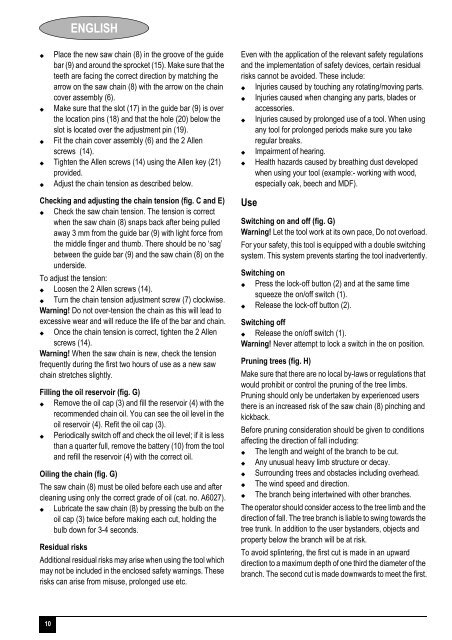BlackandDecker Tronconneuse- Gkc1817l - Type H1 - Instruction Manual (Européen)
BlackandDecker Tronconneuse- Gkc1817l - Type H1 - Instruction Manual (Européen)
BlackandDecker Tronconneuse- Gkc1817l - Type H1 - Instruction Manual (Européen)
Create successful ePaper yourself
Turn your PDF publications into a flip-book with our unique Google optimized e-Paper software.
ENGLISH<br />
Place the new saw chain (8) in the groove of the guide<br />
bar (9) and around the sprocket (15). Make sure that the<br />
teeth are facing the correct direction by matching the<br />
arrow on the saw chain (8) with the arrow on the chain<br />
cover assembly (6).<br />
Make sure that the slot (17) in the guide bar (9) is over<br />
the location pins (18) and that the hole (20) below the<br />
slot is located over the adjustm<strong>en</strong>t pin (19).<br />
Fit the chain cover assembly (6) and the 2 All<strong>en</strong><br />
screws (14).<br />
Tight<strong>en</strong> the All<strong>en</strong> screws (14) using the All<strong>en</strong> key (21)<br />
provided.<br />
Adjust the chain t<strong>en</strong>sion as described below.<br />
Checking and adjusting the chain t<strong>en</strong>sion (fig. C and E)<br />
Check the saw chain t<strong>en</strong>sion. The t<strong>en</strong>sion is correct<br />
wh<strong>en</strong> the saw chain (8) snaps back after being pulled<br />
away 3 mm from the guide bar (9) with light force from<br />
the middle finger and thumb. There should be no ‘sag’<br />
betwe<strong>en</strong> the guide bar (9) and the saw chain (8) on the<br />
underside.<br />
To adjust the t<strong>en</strong>sion:<br />
Loos<strong>en</strong> the 2 All<strong>en</strong> screws (14).<br />
Turn the chain t<strong>en</strong>sion adjustm<strong>en</strong>t screw (7) clockwise.<br />
Warning! Do not over-t<strong>en</strong>sion the chain as this will lead to<br />
excessive wear and will reduce the life of the bar and chain.<br />
Once the chain t<strong>en</strong>sion is correct, tight<strong>en</strong> the 2 All<strong>en</strong><br />
screws (14).<br />
Warning! Wh<strong>en</strong> the saw chain is new, check the t<strong>en</strong>sion<br />
frequ<strong>en</strong>tly during the first two hours of use as a new saw<br />
chain stretches slightly.<br />
Filling the oil reservoir (fig. G)<br />
Remove the oil cap (3) and fill the reservoir (4) with the<br />
recomm<strong>en</strong>ded chain oil. You can see the oil level in the<br />
oil reservoir (4). Refit the oil cap (3).<br />
Periodically switch off and check the oil level; if it is less<br />
than a quarter full, remove the battery (10) from the tool<br />
and refill the reservoir (4) with the correct oil.<br />
Oiling the chain (fig. G)<br />
The saw chain (8) must be oiled before each use and after<br />
cleaning using only the correct grade of oil (cat. no. A6027).<br />
Lubricate the saw chain (8) by pressing the bulb on the<br />
oil cap (3) twice before making each cut, holding the<br />
bulb down for 3-4 seconds.<br />
Residual risks<br />
Additional residual risks may arise wh<strong>en</strong> using the tool which<br />
may not be included in the <strong>en</strong>closed safety warnings. These<br />
risks can arise from misuse, prolonged use etc.<br />
Ev<strong>en</strong> with the application of the relevant safety regulations<br />
and the implem<strong>en</strong>tation of safety devices, certain residual<br />
risks cannot be avoided. These include:<br />
Injuries caused by touching any rotating/moving parts.<br />
Injuries caused wh<strong>en</strong> changing any parts, blades or<br />
accessories.<br />
Injuries caused by prolonged use of a tool. Wh<strong>en</strong> using<br />
any tool for prolonged periods make sure you take<br />
regular breaks.<br />
Impairm<strong>en</strong>t of hearing.<br />
Health hazards caused by breathing dust developed<br />
wh<strong>en</strong> using your tool (example:- working with wood,<br />
especially oak, beech and MDF).<br />
Use<br />
Switching on and off (fig. G)<br />
Warning! Let the tool work at its own pace, Do not overload.<br />
For your safety, this tool is equipped with a double switching<br />
system. This system prev<strong>en</strong>ts starting the tool inadvert<strong>en</strong>tly.<br />
Switching on<br />
Press the lock-off button (2) and at the same time<br />
squeeze the on/off switch (1).<br />
Release the lock-off button (2).<br />
Switching off<br />
Release the on/off switch (1).<br />
Warning! Never attempt to lock a switch in the on position.<br />
Pruning trees (fig. H)<br />
Make sure that there are no local by-laws or regulations that<br />
would prohibit or control the pruning of the tree limbs.<br />
Pruning should only be undertak<strong>en</strong> by experi<strong>en</strong>ced users<br />
there is an increased risk of the saw chain (8) pinching and<br />
kickback.<br />
Before pruning consideration should be giv<strong>en</strong> to conditions<br />
affecting the direction of fall including:<br />
The l<strong>en</strong>gth and weight of the branch to be cut.<br />
Any unusual heavy limb structure or decay.<br />
Surrounding trees and obstacles including overhead.<br />
The wind speed and direction.<br />
The branch being intertwined with other branches.<br />
The operator should consider access to the tree limb and the<br />
direction of fall. The tree branch is liable to swing towards the<br />
tree trunk. In addition to the user bystanders, objects and<br />
property below the branch will be at risk.<br />
To avoid splintering, the first cut is made in an upward<br />
direction to a maximum depth of one third the diameter of the<br />
branch. The second cut is made downwards to meet the first.<br />
10
















